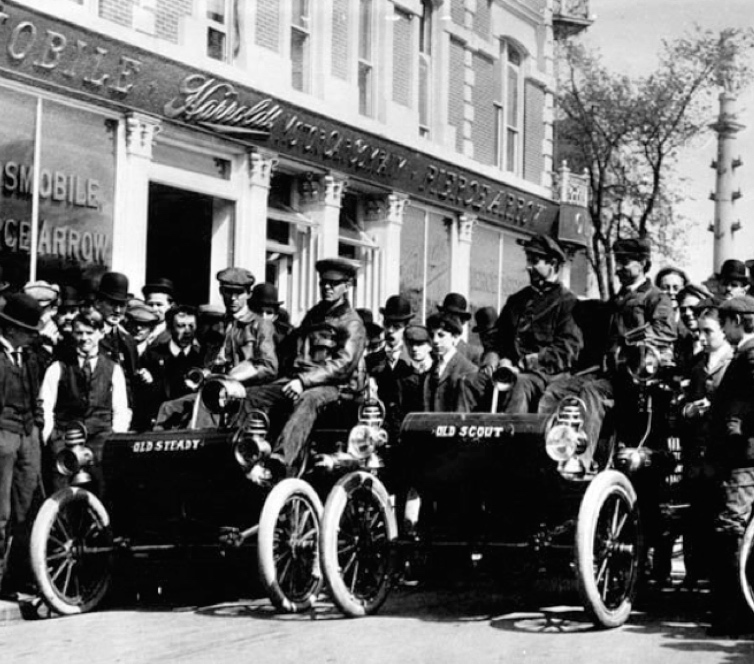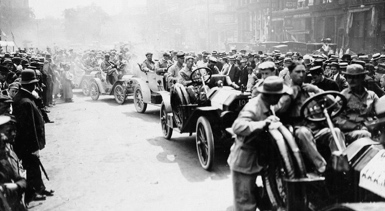
Each year, somewhere between 12- and 15-million motor vehicles — cars and trucks, minivans and sedans, coupes and convertibles — are banished to American wrecking yards, and in many cases to the crusher. And those are just the intentional losses.
Everyone knows the fate of the Norseman, the Ghia-built Chrysler concept that went down with the Andrea Doria. But did you know neither of the Curved-Dash Oldsmobiles that competed in the first motorcar race across the country in 1905 still exist? In fact, none of the 21 cars participating in the original Glidden Tour — from Detroit to Kansas City in 1909 — are known to survive.
And it’s not just the cars. The remaining pioneers and even the scions of the automotive industry are getting on in years.
Oh, and one more thing: There are a lot of romantic myths about many of the historic cars that do exist, and it’s amazing how many of them prove to be sheer fantasies when real research is conducted.
The Historic Vehicle Association has taken on the job of preserving America’s automotive heritage and of sharing that heritage well beyond the traditional group of car enthusiasts.
“From hobby to heritage,” said HVA president Mark Gessler.
“But where do automobiles fit?” wondered Bruce Judd, who in 1980 was among the first to specialize in historic preservation architecture and for eight years was the Presidential-appointed expert member of the Advisory Council on Historic Preservation, the federal agency overseeing national architectural preservation issues.
“Buildings are a physical link to our past,” Judd told the recent HVA Summit meeting held near Washington, D.C. “This is where something happened and now you can walk through it.”

But, he added, “Automobiles also link us to our past. We also have lived with cars. They are an important part of our lives.”
Judd offered examples ranging from the Rosa Park bus to the number of people who possess photographs of themselves and their family members posed beside their cars, if not sitting at the steering wheel.
In 1966, Congress passed the National Historic Preservation Act. Today, more than 80,000 buildings are included in the National Register of Historic Places. The HVA has worked for several years with the Department of the Interior, the National Park Service and the Library of Congress and its Historic American Engineering Record to lay the groundwork, establish criteria and finally to launch a National History Vehicle Register to celebrate the automobile’s place in American culture.
Gessler said the HVA was very encouraged when, at its first meeting with officials of the National Parks Service’s Heritage Documentation Programs, “The HDP already had a list of automobiles and asked what the HVA thought of their list.”
So far, five vehicles have been vetted, photographed and measured via laser scanning, had their stories researched and documented, and been announced for inclusion on the historic vehicle register.
Those vehicles are the 1964 Shelby Cobra Daytona Coupe, the 1964 Meyers Manx dune buggy, the 1939 “Boyle Special” Maserati 8CTF that won the 1939 Indianapolis 500, a 1918 Cadillac Type 57 still carrying a bullet hole from its service with American troops during World War I, and the 1947 Tucker 48 prototype known as “The Tin Goose.”
Others vehicles are going through the process and will be added to the register in the coming months. However, in meeting the standards for official federal recognition, it costs the HVA $30,000 to $35,000 per vehicle, Gessler said, and those figures don’t count HVA staff time — the HVA has five on staff — for research and photography and other activities. Most of the expense is for photography (including the conversion of digital to large-format film, to have vehicles 3D laser scanned for precise measurement, and for producing the fully cited, primary-source documentation (think master’s thesis level of necessary research).
Why undertake such an effort and expense?
“These are gifts to the American people,” Gessler said of the recognition of cars as cultural artifacts and the preservation of not only vehicles but their stories. It’s a sharing of heritage, he said, from the collector community to the general public.
One challenge the HVA faces is just how to share, how to communicate those stories with the public at large. Another is raising sufficient funding, or else finding a way to reduce the cost per car. Another is deciding whether five cars per year is the right number, or should it be 50, or even many more? Gessler noted that in 40 years, 80,000 buildings have gone through the historic places registration process. That averages out to 200 a year.
Including buildings but not cars “is like a stage without the actors,” C. Ford Peatross told the HVA Summit. For the past 40 years, Peatross has been the director of the Library of Congress’ Center for Architecture, Design and Engineering. And it’s not just cars, he added, but also trucks and motorcycles.
Peatross is a lifetime car guy. His father drove in the first two NASCAR races and Peatross said he’s been told his father is the person who taught Junior Johnson how to drive.
“The love of and obsession with cars is embedded in our American psyche,” Peatross said, supporting that statement with a long list of quotations about cars and American society from many prominent authors.
Also speaking to the HVA Summit was Roger White, who for 33 years has been curator of road transportation for the Smithsonian’s National Museum of American History. The museum’s collection includes 73 cars selected primarily because of their unique features, their role in everyday life and in social issues, as turning points in design and use, and for their influence during an era.
When White arrived, the collection included no post-war vehicles, and it has not added any since acquiring a 1997 GM EV1 electric vehicle in 2005.
Like the HVA, White works with limited staff. He said the museum has no car experts among its five-person staff of artifact conservation specialists, nor does it have its own vehicle restoration shop.
But, he noted, “The car arrived before all the systems needed to support it.”
White talked about such things as good roads, service stations, safety systems and the like. However, his words also would seem to apply to the HVA and its trailblazing efforts on behalf of the automobile and its role in American culture and heritage.
The HVA has taken the wheel. Will the classic car community be eager to climb aboard for this road trip?





80,000 buildings over 40 years averages 2,000 per year, not 200.